Anthony Louis's Blog
October 10, 2025
The Birth Chart of Carl Gustav II Jung
The famous Swiss psychiatrist Carl Jung was born in Kesswil, Switzerland (47n36, 9e20) on 26 July 1875, in his own words “when the last rays of the setting sun lit the room.” The precise time of birth is uncertain but, if Carl’s words are accurate, he was born very close to sunset. According to astro.com, Jim Eshelman calculated that astronomically the last rays of the sun (without parallax) lit the room at about 7:41 PM LMT.
In 1775 Switzerland there was no unified “Swiss time.” Each town or city used its own local mean time (LMT) based on the sun’s position at that specific location. Birth times cited in Astro.com from various sources include 7:24 PM Bern Mean Time, 7:37 PM Thurgen, 7:24 PM near Zurich, 7:30 PM Bale, and so on. Local times could vary by several minutes in neighboring places.
Carl’s daughter Gret Baumann-Jung, a practitioner of astrology, reports her father’s birthtime as 19:32 LMT (7:32 pm LMT) and she published the chart she uses for her father in the book Jung on Astrology (2017). Her paper was delivered in German at the Psychological Club Zürich in October 1974. Unfortunately, there are varying birth times recorded for C. G. Jung, and it is not clear whether this is the chart Carl Jung used for himself, or whether this is his daughter’s best guess as to the actual chart. The inclusion of the asteroids near the western horizon suggests that this is Gret Baumann-Jung’s chart for her father rather than the one Jung used for himself because he died in 1961 and the four major asteroids (Ceres, Pallas, Juno, and Vesta) weren’t widely incorporated into astrological practice until the 1970s-1980s.
 Birth chart of Carl Jung (with Campanus houses) according to his daughter Gret Baumann-Jung, published in “Some Reflections on the Horoscope of C. G. Jung” Spring (1975), 35–55, and reproduced in the book Jung on Astrology (2017).
Birth chart of Carl Jung (with Campanus houses) according to his daughter Gret Baumann-Jung, published in “Some Reflections on the Horoscope of C. G. Jung” Spring (1975), 35–55, and reproduced in the book Jung on Astrology (2017).It is a MOON day during a SUN hour, the 12th and final hour of daytime.
Gret’s chart for her father, cast for 7:32 PM LMT, seems to fit the facts fairly well. The sun is just above the western horizon and about to set. A problem with this chart is that the Asc at 2 1/2 Aquarius means the MC lies at 29 Scorpio 56′, just 04′ of arc away from Sagittarius. If he were born a mere 15 seconds later on the clock, the MC would be in Sagittarius.
Which MC makes more sense symbolically? A Scorpio MC, ruled by Mars, fits Jung’s interest in depth psychology and ancient wisdom; however, a Sagittarius MC, ruled by Jupiter, is a good match for his international recognition as a teacher and author in search of knowledge and wisdom.
The final term (bound) of Scorpio belongs to Saturn which is Rx in its domicile Aquarius in the 1st house (the self). The first term (bound) of Sagittarius is ruled by Jupiter which is direct in Libra in the 8th house (ancient occult knowledge). Jupiter and Saturn form a mutually applying trine. Mars (ruler of Scorpio) is stationary direct and peregrine in Sagittarius in the 11th house from which it forms a harmonious sextile with both Jupiter and Saturn.
A case could be made for either MC, Scorpio or Sagittarius. I lean toward Sagittarius because Jupiter conjoins the fortunate fixed star Spica in Libra in the 8th house, which seems fitting for a revered psychoanalyst who explored the hidden depths of the psyche and left a lasting legacy for future students of analytic psychology.
We can use predictive techniques to help decide between a Scorpio and a Sagittarius MC. A significant 10th house event occurred when Jung was 25 years old. In his autobiography Jung writes: “On 10th December, 1900, I took up my post as assistant at the Burghölzli Mental Hospital, Zürich.” His age on that date was 25.37 years old.
At age 25 his Lord of the Year by profection of the Ascendant sign is Jupiter, ruler of Pisces, the 2nd sign from the Ascendant. The activatin of Jupiter by profection, with Sagittarius ruling the 10th sign, would make sense in a year of great professional advancement. The Lord of the Orb at age 25 is Saturn (natally the Sun is hour lord) which partners with the Lord of the Year, Jupiter. Saturn occupies the 1st house in its domicile Aquarius and rules the 12th house of hospital and mental health institutions. Saturn also trines the MC.
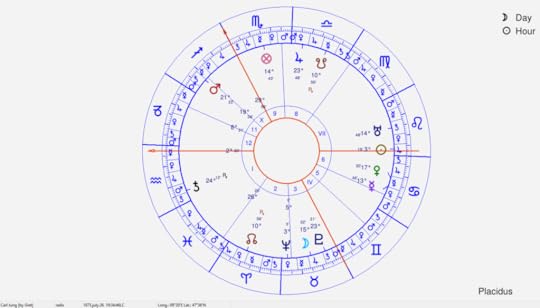 Carl Jung’s Birth Chart with Placidus Houses, according to his daughter Gret.
Carl Jung’s Birth Chart with Placidus Houses, according to his daughter Gret.In Morinus freeware, this is cast for 19:34:46 LMT.
The identical chart cast with Janus software has a birth time of 19:27:11 LMT, a difference of 00:07:35. (I don’t understand why this discrepancy exists.)
If we consider the directions (Placidus, zodiacal, without latitude, Naibod key) of the MC directed to Mars, Jupiter, and Saturn around December of 1900, in Janus software we find: Mars without latitude to the MC in October of 1898, the Sinister Sextile of Jupiter to the MC in June of 1901, and Dexter sextile of Saturn to the MC in Novermber of 1901, which means that the MC of Gret’s chart for her father is a bit too early in the zodiac and should probably be in the first degree of Sagittarius.
If we adjust the time of birth and recalculate the directions, we find in Janus software that on 10 December of 1900 Mars without latitude crosses the MC by primary motion with a birth time of 19:18:35 LMT; on that same date with a birth time of 19:29:06 LMT the Sinister Sextile of Jupiter reaches the MC by primary motion; and with a birth time of 19:30:49 LMT the Dexter sextile of Saturn arrives at the MC by primary motion on 10 December 1900.
If we look at the directions around the time of his passing (6 June 1961), with a birth time of 19:27:11 LMT In Janus software, the opposition of Mars comes the the Ascendant on 12 September 1961, about 3 months after the event. This implies that the original MC is too early in the zodiac and ought to be in early Sagittarius. If we adjust the birth time in Janus to 19:28:14 LMT, the directed opposition of Mars arrives at the Ascendant on 6 June 1961.
Isaac Starkman, who specialized in rectification, using techniques developed by Alexander Marr, tested many events from Jung’s life and concluded that he was born around 19:28:20 LMT, with the Ascendant at 2 Aqu 54′ and the MC at 0 Sag 11′. My own experimentation with rectifying Jung’s chart comes to a virturally identical conclusion. Here is the rectified chart.

Starkman’s Rectified Chart for Carl Jung:


I found that different software gave very slightly different results, probably because of the level of accuracy of their calculations. Sometimes the coordinates were slightly different. I didn’t use the precise coordinates of Jung’s birthplace, just the city. What was most compelling was that the “rectified” time from a group of events, using primary directions, produced a birthtime of 19:28:18 LMT (quite close to Starman’s 19:28:20 LMT. When I ran the Placidus primaries for 1961, it showed the opposition of Mars on the Ascendant on 1 June 1961, just 5 days from the date of Jung’s demise at age 85.
Using the 19:28:18 LMT chart, in the distributions (circumambulation) from his Sun (hyleg in this chart), timed with mean solar arc, at age 85 his divisor was Saturn, and in April of 1961 Saturn’s partner became Mars, which crossed the Dsc by primary motion on 1 June 1961, almost exactly on the date of Jung’s passing.

September 27, 2025
The New York Times as Yellow Journalism and Fake News
When it comes to covering topics in astrology, the New York Times resorts to fake news replete with sensationalism and silly exaggeration. The most recent example is a piece written by Aatish Bhatia, Francesca Paris and Rumsey Taylor and published on 7 September 2025. These authors, who appear to be totally ignorant of astrology, should be ashamed to pass themselves off as journalists. They ignore fact-checking and repeat nonsense that has been thoroughly debunked by scholars who actually know the history of horoscopic astrology dating back to Hipparchus and Claudius Ptolemy.
 Claudius Ptolemy
Claudius PtolemyThe title of the article by Bhatia, Paris and Taylor is “Your Zodiac Sign Is 2,000 Years Out of Date.” Unfortunately, these uninformed authors have not done their research and are unaware of the difference between a zodiac sign and a constellation in the zodiac band of stars in the heavens. In their confused state, they write: “Sept. 27 is in Libra because 2,000 years ago, this constellation was more or less behind the sun on that date.” What are they talking about? September 27th is a date, not a planet. They seem to mean that on Septermber 27th in the year 0025 CE (2000 years ago) the sun appeared to be in the constellation of stars called Libra. This is true, but constellations are not zodiac signs.
They correctly state “But this year [2025], the actual constellation behind the sun on Sept. 27 is Virgo, not Libra,” but they are totally unaware that constellations are not zodiac signs. How can they be so uninformed about such a basic tenet of astrology? Can we really expect the New York Times to be concerned about fact-checking which might interfere with their love of sensationalism?
Since these author don’t bother to fact-check what they write, let me briefly clarify matters for them. My hope is to to dispell their ignorance and fill in some gaps in their education.
A zodiac sign and a zodiac constellation are related but distinct concepts. Astrologers have been aware for a few thousand years that there are 13 constellations, including Ophiuchus, along the ecliptic circle.
Zodiac Constellations are star patterns in the sky that lie along the ecliptic (the path that the Sun appears to travel along throughout the year). There are 13 zodiac constellations that the Sun passes through, including the 12 traditional ones plus Ophiuchus. These are physical groupings of stars that form recognizable patterns when viewed from Earth.
Early astronomers (astrologers) devised a method to orient themselves in the heavens so that they could accurately track the movement of the stars and planets. Because the planets travel close to the ecliptic (the path of the Sun), they divided the ecliptic circle into twelve 30-degree segments, which they called “signs.” To facilitate communication, they gave the 12 equal 30-degree signs (mathematical divisions) names corresponding to the constellation of stars they most closely correlated with in the heavens some 2000 years ago.
Thus, there are the 12 equal divisions of the ecliptic (called “zodiac signs“) in astrology, each spanning exactly 30 degrees. The signs are named after constellations but in the tropical zodiac are based on a fixed calendar system (with the vernal equinox in the northern hemisphere as the start of the zodiac sign Aries). Astrologers in India prefer to start the zodiac at the beginning of the constellation Aries; this is the “sidereal” zodiac, but its signs are also exact 30-degree segments of the ecliptic circle and are not constellations.
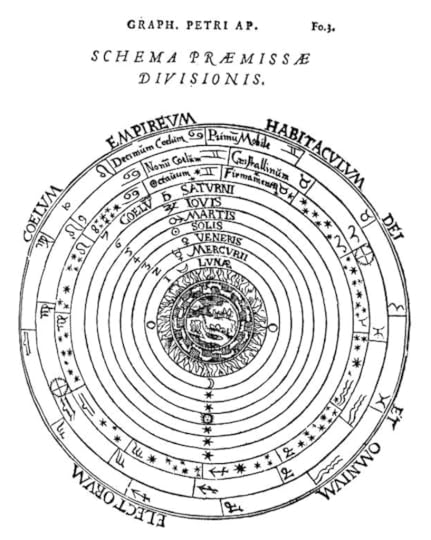 Description
DescriptionAristotelian cosmology, with astrological and zodiacal symbols. This Earth-centred (geocentric) worldview originated with the Ancient Greeks and dominated medieval Europe until the time of Copernicus (1543). The heavenly bodies circled the Earth attached to spheres. At centre are the four elements of Earth, Water, Air and Fire. Then there are successive spheres for the Moon, Mercury, Venus, the Sun, Mars, Jupiter and Saturn. The outer three spheres are: the Firmament (including the stars), the Crystalline Heaven, and the Primum Mobile. Beyond this is the Empyreal Heaven, the Abode of the Blessed. Published in Cosmographia (1524) by the German astronomer Petrus Apianus.
Note how the outer circles show the difference between the tropical and sidereal zodiacs, which was well-known to ancient Greek astrologers but is apparently unknown by the writers of the modern New York Times.
The constellations (star patterns) vary greatly in size, and the Sun spends varying amounts of time in each. In contrast, the zodiac signs are uniform 30-degree segments. Due to precession (Earth’s axial wobble), the zodiac signs have gradually shifted relative to the constellations over thousands of years, but the zodiac SIGNS, which are mathematical divisions of the 360-degree ecliptic circle, are not the same as the zodiac CONSTELLATIONS, which are patterns of stars that vary in size.
Astrology uses 12 SIGNS of exactly 30-degrees each while astronomy recognizes 13 star patterns called CONSTELLATIONS along the ecliptic. The “missing” constellation (star pattern) Ophiuchus sits between Scorpius and Sagittarius. Ophiuchus is NOT a zodiac SIGN because it is not one of the twelve exact 30-degree mathematical segments of the zodiac circle. Zodiac signs are exact 30-degree divisions of a circle, while zodiac constellations are the actual star patterns which the Sun appears to move through during the year. The zodiac signs are named after 12 of the 13 the zodiac constellations as they appeared about 2000 years ago.
I would ask authors Aatish Bhatia, Francesca Paris, and Rumsey Taylor to repeat after me, 100 times, “Zodiac signs are not constellations, even though they are named after constellations. Zodiac Signs are the twelve equal 30-degree segments of the ecliptic circle, whereas the zodiac constellations are the thirteen star groups that lie along the ecliptic circle. Signs are not constellations.”
To believe that zodiac signs are the same as zodiac constellations is simply an admissition of ignorance, but the New York Times seems to value sensationalism over truth and fact-checking. Their article is the epitome of yellow journalism.
Can you spot the difference between the next two images?

 Yellow Journalism at its Finest: The New York Times
Yellow Journalism at its Finest: The New York Times
September 25, 2025
Morinus Lost in Translation
Recently a student of astrology asked me why in some of the texts she was reading the author refers to a planet situated toward the end of a mundane house as actually being in the next house. This did not make sense to the student as she looked at the astrological chart under discussion.
I referred this student to William Lilly’s Christian Astrology, Book 1, Chapter IV, in which Lilly presents a square horoscope chart with #1 drawn on the cusp of the Ascendant and #2 on the cusp of the second house. Lilly the refers to the space contained between #1 and #2, and states “what space is contained between the figure 1 [#1] to the figure 2 [#2] is of the first house, or what planet you shall find to be in that space, you shall say he is in the first house; yet if he be within five degrees of the Cusp of any house, his vertue shall be assigned to that house whose Cups he is nearest…” (bold mine).
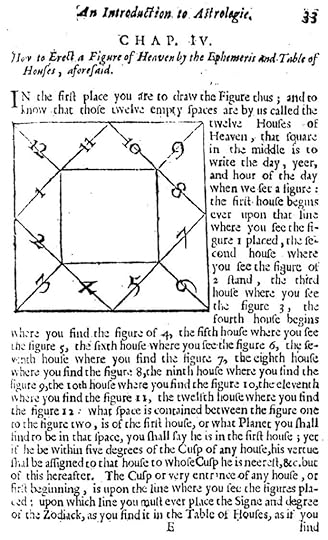
Some modern astrologers have not read or have misunderstood Lilly and do refer erroneously to a planet near the end of a house as being present in the next house, which Lilly would not endorse. Morin makes a similar point in his writings. According to Morin, a planet that lies between the cusps of a house occupies that house; but if the planet lies toward the end of the house and the cusp of the next house lies within the planet’s orb, then the influence of the planet (what Lilly calls its virtue) will be experienced primarily in the next house.
Let’s look at an example from Morin’s Book 23 on Revolutions.
 Morin’s 23rd solar return at his birthplace
Morin’s 23rd solar return at his birthplaceMorin tells us that his 23rd year of life was particularly dangerous and difficult. As a result of his involvement with a famous woman, he suffered serious injuries to his chest in the area below the heart and to his left thigh, which caused him to almost bleed to death. He survived and fled his hometown to avoid further dangers. Morin explains that these extremely unfortunate incidents were related to his involvements with women as promised in his natal chart by the promience of his natal Venus and his natal 12th, 8th and 5th houses.
Considering his 23rd solar return in the context of his birth chart, Morin writes: “Which granted, it is already plain at the outset that all the planets are situated in houses 5, 7, 8 and 9, to which the two accidents mentioned above belong.” (James Holden translation, revised 2nd edition, 2003, p.39, italics mine)
Looking at the 23rd solar return chart drawn by Morin himself, however, we see that Saturn actually lies in the 4th house — which contradicts Holden’s translation that “all the planets are situated in houses 5, 7, 8 and 9.” We know from Morin’s writings that, like Lilly, he would regard Saturn as a 4th house planet but whose major influence would be felt in the 5th house which lies within close orb of Saturn’s planetary influence.
Pondering this discrepancy, I wondered if James Holden, an excellent translator of Morin’s works, had somehow mistranslated this passage from Morin. Looking up the original Latin, I found:
 Note the last line of this passage from Morin in which he refers to houses 5, 7, 8, and 9.
Note the last line of this passage from Morin in which he refers to houses 5, 7, 8, and 9.In this passage from Morin, he discusses the natal promise of danger to life caused by his involvements with women and then refers to his 23rd revolution. The last line reads (in Latin): Quo supposito, jam primó patet, omnes Planetas hac in revolutione versari in domibus 5. 7. 8. 9. ad quas duo illa superius dicta pertinent accidentia. The important Latin verb here is “versari” which Holden understood to mean “are situated in,” but we can see from the chart that Saturn is NOT situated in houses 5, 7, 8, or 9.
We must then ask whether the Latin verb “versari” has other meanings consistent with the figure drawn by Morin and published in his book. Looking up “versari” in a Latin dictionary, I found the following:
The base verb of “versari” is “versor, versari, versatus sum“ — a deponent verb which has passive forms but active meanings, including:
1) To be busy with/engaged in – often used with activities, studies, or occupations.
2) To move about/turn – in a physical or metaphorical sense.
3) To be situated/found – referring to location or circumstances.
4) To be involved in/concerned with – particular affairs or matters.
Given this clarification of the various meanings of the verb “versor,” a more accurate translation of Morin’s sentence, “Quo supposito, jam primó patet, omnes Planetas hac in revolutione versari in domibus 5. 7. 8. 9. ad quas duo illa superius dicta pertinent accidentia” would be something like:
“Granted this [the natal promise], it is immediately clear that all the planets in this revolution are engaged (involved) with the 5th, 7th, 8th, and 9th houses, to which the two accidental circumstances mentioned above pertain.”
Take-home lession: when reading Morin’s Latin text, by “omnes Planetas versari” he might mean that “all the planets are situated in” but more likely he has in mind that all the planets are engaged with or are involved in the signfications of a house or group of houses.
 Morin’s Natal Chart and his 23rd Solar Return when he almost bled to death
Morin’s Natal Chart and his 23rd Solar Return when he almost bled to deathIn the modern calculation of Morin’s 23rd solar retrun, Saturn lies in the 4th house about 2.5 degrees away from the 5th house Regiomontanus cusp and is applying to the 5th cusp, so it has a strong impact on 5th house matters. Morin gave Saturn an orbe of 14 degrees, with a radius of 7 degrees. Thus, the orb of Saturn extends back from its position toward the end of the 4th house to 17 Sag 50′ and forward to 1 Aqu 50′ in the 5th house.
Natally the domicile rulers of 5 (romance), 7 (women, intimate relationships), 8 (mortal danger) and 9 (travel, foreign interests) are closely conjoined at the cusp of the 12th (hidden enemies, misery, undoing). When these houses became active in the solar return of 1605, Morin almost lost his life due to involvement with a famous woman.
 Morin’s birth chart with 23rd solar return superimposed outside.
Morin’s birth chart with 23rd solar return superimposed outside.
September 19, 2025
Reflections on the Chart of Pico della Mirandola
The youthful Renaissance philosphoper Pico della Mirandola was a severe critic of divinatory astrology. Pico was born on 24 February 1463 (julian) about about 2:42 unequal (planetary) hours after sunet (2h. 42m. post occasum Solis) in Mirandola — a small town that was part of the duchy of Ferrara and is now in the province of Modena, Emilia-Romagna region, Italy. The scholarly prince is known as “Pico della Mirandola” because of his birthplace and noble heritage, which are linked to this town.
The sources of Pico’s birth information are John Gadbury who reproduced the chart of Pico in his collection of nativities; and Morinus, who discusses Pico’s chart in Book 22, citing as references Junctinus (Giuntini), Cardan, Lucio Bellantio of Siena, Antonio Syrigato of Florence, and Angelo de Catastive. Morin uses a natal Asc for Pico of 18 Libra, as does Junctinus; Gadbury has the Asc at 17 Libra, and Cardan at only 6 Libra (which is probably due to a typographical error).
Larry Ely (on astro.com) notes that Pico’s friend, Girolamo Benivieni, who was conversant with astrology, prepared Pico’s birth chart for him. Morin comments that Pico was aware of his own natal chart and he quotes a section of Pico’s famous critique of astrology, in which Pico cites the positions of his natal Moon and Sun in his birth chart as well as the separating sextile between them.
Here is Gadbury’s version of Pico’s birth chart:

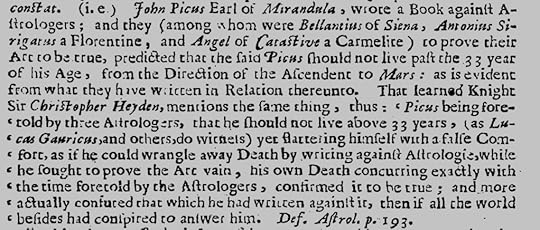
Gadbury notes that some astrologers among Pico’s contempories countered Pico’s arguments against predictive astrology by examining his chart and warning that he was in danger of death by his 33rd year of life because the direction of the Ascendant to Mars would perfect in his 33rd year of life (age 32).
Mars is strong in its domicile Scoprio in Pico’s birth chart but is badly conditioned by its square to malefic Saturn in Aquarius in the 4th house of endings. Mars also casts its malefic opposition aspect into the 8th house of death where that aspect is joined to the Moon in Taurus (the sign of detriment of Mars). The Moon, by Bonatti’s criteria, is the hyleg (life-giver) of Pico’s chart. Natal Mars opposes the 8th house Moon, and both Mars and the Moon square Saturn in the 4th — a difficult T-square configuration linked to the 4th of endings and the 8th of mortal danger. Morin agrees with this delineation and feels that Pico’s death on 17 November 1494 (at age 31) confirms the validity of astrological principles and predictive techniques. Modern forensic analysis showed that Pico died of arsenic poisoning, a common medieval method to get rid of your enemies and one related to Mars and Scorpio.
 Pico’s birth chart with Gadbury’s choice of MC and ASC, calculated by modern computer.
Pico’s birth chart with Gadbury’s choice of MC and ASC, calculated by modern computer.Comparing the modern calculations with those in Gadbury’s chart of Pico’s birth, we see that planetary positions are sometimes off by a couple of degrees, which could make a difference of a couple of years in the timing of primary direcitons. Mars, in particular, is important because a direction involving Mars is this chart’s claim to fame. To paraphrase Morinus, Pico died from the direction of his Ascendant to the 2nd house Mars, which opposed the 8th house Moon in Taurus (the detriment of Mars), with both the Moon and Mars square the 4th house Saturn in Aquraius, as had been foretold in advance by Italian astrologers who examined Pico’s birth chart in repsonse to his criticisms of astrology.
Pico’s main critique was that belief in the ability of astrology to predict the future was deterministic, and as such undermined both divine providence and human dignity and free will. If the stars determine our destiny, then even God is subject to astrological laws, and humans have no say in what happens to them. Humans cannot be held responsible for what they do, and God cannot show benevolence because the outcome is alread predetermined. In addition, Pico condemned astrology as a dangerous form of superstition, but added that its apparent efficacy might be due to the work of demons!
Morinus, a devout Catholic, was especially critical of Pico and felt that the Renaissance philosopher was rather an ignormaus regarding the pricincples of astrology — a disciple which Morin regarded as evidence of the divine handiwork involved in creating and animating the universe.
There is a question in the literature about Pico’s age at the time of his demise (17 Nov 1494, julian). In the 15th century Christian Europe before the Gregorian calendar reform, some regions started the new calendar year on March 25th in the Julian calendar. Pico was born on 24 February 1463 (julian), which is a date before March 25, when 1464 began. Thus, if he died on 17 November of 1494, he would have been 30 years and about 9 months old. On the other hand, if the calendar year changed on January 1, 1463, then Pico would have been 31 years and almost 9 months at his demise (in his 32nd year of life).
If we direct the Asc (at 17 Libra 13′) to the older position of Mars (12 Scorpio) with latitude, we get an arc of direction of 31.48 equatorial degrees, which at Plotmey’s key corresponds to age 31 years 5.8 months. At the Naibod rate (which was proposed in the 16th century) 31.48 equatorial degrees corresponds to age 31.94 (his 32nd year), or 31 years and 11.3 months of age (his 32nd year).
If we calculate the direction of the Asc to Mars without latitude, that is, the direction of the Asc to the degree of Mars on the ecliptic, then the arc of direction is 32.88 equatorial degrees, which corresponds to 32 years 10.56 months (his 33rd year) at the Ptolemy Key, and 33 years 4.3 months (his 34th year) at the Naibod rate. It appears that the astrologers of Pico’s era directed his natal Asc to the somewhat erroneious ecliptic position of Mars (without latitude) and calculated timing according to Ptolemy’s Key of one equatorial degree for each year of life. Mars was, in fact, 1.8 degrees later along the zodiac than the position used by the Renaissance astrologers of Pico’s time. Thus, the timing must be off by a couple of years. His demise should not have occurred until 1497 or 1498, rather than 1994 when it did take place. Houston, we’ve got a problem!
It could be that the chart was “rectified” after Pico’s death to adjust the Ascendant to agree with the actual length of Pico’s life. This explanation does not make sense because the astrologers of Pico’s time allegedly predicted his death well before it happened, and they based their prediction on the wrong position of Mars (as 12 Libra rather that 13 Libra 48′) and the Ascendant apparently based on Pico’s own family records of his birth.
It could be a lucky coincidence that the Ascendant, based on the clocks in the castle where Pico was born, was just enough inaccurate to offset the inaccurate position of Mars based on the poor observational abilities of the epoch. Mechancial clocks of the 15th century apparently were not known to keep precisely accurate time, often being off by 10 to 15 minutes, which could span some 4 degrees on the Midheaven of a birth chart. Maybe the errors on the castle clock were just enough to offset the errors in the astronomical observation of the position of Mars, so that the astrologers got the right output with the wrong input.
It could be that the astrologers of the period used the wrong primary direction to predict Pico’s demise. Mars makes a lot of sense, but its ecliptical position is wrong. Could a direction involving malefic Saturn have accounted for his death in November of 1494? Such a direction makes sense because Saturn is closely configured with Mars, the Moon, and the 8th (death), 4th (endings, the grave) and 12th (hidden enemies, undoing) houses. Saturn conjoins Mercury, the ruler of the 12th; and Mercury closely squares the Moon in the 8th. The Moon also rules the cusp of the 8th by its exaltation in Taurus. By primary direciton, Saturn is approaching the IC or 4th cusp. Will Saturn arrive at the IC on the meridian axis around the time Pico turns 31 or 32 years old (his 32nd or 33rd year of life)?
Saturn’s latitude is 1 degree 04′ below the ecliptic. If we adjust the birth time to 8:35:46 PM LMT (from Gadbury’s 8:38:56 PM LMT) — a diffrence of about 3 minutes — then the body of Saturn conjoins the IC by primary motion with an equatorial arc of 30 deg 17 min, which corresponds to 17 Nov 1494 at the Naibod rate. With this same adjusted birth time (3 minutes earlier than in Gadbury’s chart of Pico), the Asc is directed to the body of Mars with an equatorial arc of 32 d 24′, withich corresponds to 23 Nov 1495. The direction of the Asc to Mars without latitude does not perfect until 25 April 1497.
Given the accurate planetary positions in this version of Pico’s birth chart, and adjusting the birth time to about 3 minutes earlier than in Gadbury’s and Morin’s chart of the event, it seems reasonbly likely that Pico was born around 8:35:46 PM LMT and that the direction of the MC to the opposition of natal Saturn (or IC to Saturn) corresponds to his demise at the age of 31 and 9 months (in his 32nd year of life).
To check this rectification, let’s look at an event in Pico’s life, based on his own observations about his chart. In Book 22, James Holden (p. 143) translated a passage from Pico’s critique of astrology, primary directions in particular. Pico writes: “this invention of directing is nothing other than to subject things not only to the constellations [configurations] which are, but also to those which will be. For what else is it to say that the Moon, which at my birth was moving away from the sextile rays of the Sun is, however, going to produce a misfortune at some time then from the square aspect of the Sun, which it was not in fact under when I was born. … when it passes over after a certain number of years from it, will that calamity be inflicted? … and if it is going to be in effect at some time afterwards, it will nevertheless mean nothing to me.“
Pico is saying that at his birth the transiting Moon (in 25 Taurus) is moving away from the sextile aspect of the Sun (in 14 Taurus, because the Sun lies in 14 Pisces). He believes it is ridiculous to think that when the Moon, at some future date, connects with 14 Gemini (which is the degree of the square of the Sun) by primary direction, some significant “misfotune” or “calamity” will occur in his life. Because the square aspect of the Sun to the Moon is not active at the time of his birth, Pico argues that it cannot come into effect at some future date due to the imaginary motion of the celestial sphere. He concludes stating: “It is plain, therefore, how absurd, false and unsuitable is the proposition of directing, which astrologers use daily.”
Although Pico doesn’t mention it, the square aspect of the Sun falls into Gemini in the 9th house, so this future “misfortune” or “calamity,” supposedly due to the Sun squaring Moon by direction, will likely involve 9th house matters such as travel, teaching, writing, publishing, lecturing, religious matters, philosophy, law, theology, divination, churches, foreign interests, etc.
This next image is Pico’s chart with the rectified birth time of 8:35:46 PM LMT. The position of the Moon in this chart is topocentric, which takes parallax into account. Martin Gansten recommends using the parallax position of the Moon and, following his advice, I have found that it does give more accurate timing results in primary directions.
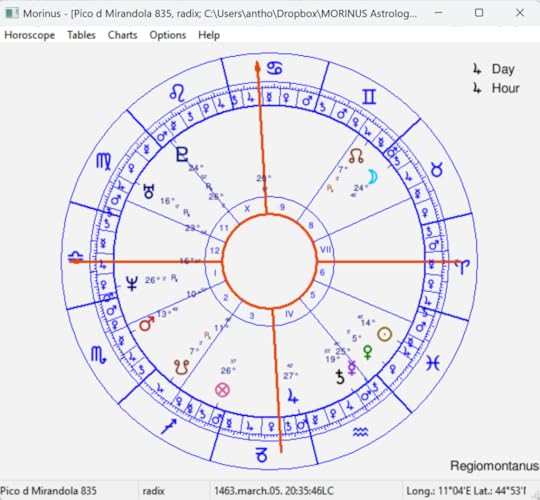 Rectified Chart of Pico based on direction of IC to Saturn at the time of his demise.
Rectified Chart of Pico based on direction of IC to Saturn at the time of his demise. ASC at 16 Libra 37′
MC at 20 Cancer 13′
He is born on a Jupiter day during a Jupiter hour.
These directions were calculated with Morinus free software, using the Naibod Key, and the latitude of the Moon (the Sun always has 0 degrees of ecliptic latitude):
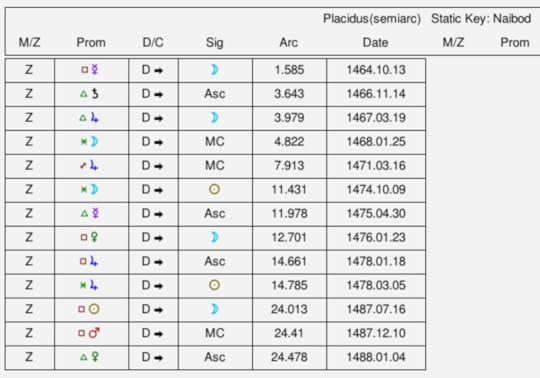
Pico argues that it is absurd to believe that a direction, such as the Moon in the unfortunate 8th house directed to the square of the Sun in the 9th house could indicate a future misfortune. We see in this list of his directions (based on the rectified chart), the 9th house square of the Sun comes to the 8th house Moon in the middle of 1487 when he is 24 years old. It is followed by the square of Mars arriving at the Midheaven at the end of 1487. All-in-all, 1487 looks like a significantly difficult year with regard to 9th and 10th house matters. Let’s see what happened in Pico’s life in 1487.
To maintain my objectivity, I asked the AI site https://app.agnes-ai.com/ whether 1487 was a difficult year in the life of Pico. Here is the response, copied and pasted verbatim:
________________________________________________________________________________
“The year 1487 was indeed a very challenging and “bad” year for Pico della Mirandola, marked by significant controversy and persecution by the Church.
Here’s what happened:
The 900 Theses: In December 1486, following the success of his “Oration on the Dignity of Man,” Pico published 900 Theses (or Conclusiones) for public disputation in Rome. These theses covered a vast range of topics, including philosophy, theology, Kabbalah, and magic. He invited scholars from all over Europe to come to Rome in January 1487 to debate them, even offering to pay their travel expenses.Papal Condemnation: However, the content of some of his theses raised immediate suspicion and alarm within the Church authorities. A commission was appointed by Pope Innocent VIII to examine them.Condemnation of 13 Theses: The commission found 13 of his theses to be heretical and others to be dangerous or suspicious. Pico defended his positions vigorously, but the Pope ultimately issued a papal bull in August 1487, condemning these 13 theses and forbidding the public disputation of all 900.Flight and Arrest: Fearing for his safety and possible arrest by the Inquisition, Pico fled. He was eventually arrested in France in 1488.Imprisonment and Release: He was imprisoned but was eventually released due to the intervention of powerful patrons, particularly Lorenzo de’ Medici, who had great influence with the Pope.Continued Trouble: While he was eventually absolved by Pope Alexander VI in 1493, the events of 1487 cast a long shadow. He spent much of the rest of his life dealing with the fallout of this condemnation and its implications for his intellectual freedom. He was never able to hold the public disputation he had envisioned.So, in summary, 1487 was a year where Pico’s intellectual ambitions clashed severely with the doctrines of the Catholic Church, leading to condemnation, flight, and arrest, marking a significant negative turning point in his life.”
___________________________________________________________________________________
Based on the response from the AI site, it looks to me like Pico was wrong in his assessment of the direction of the 8th house Moon, ruler of his Midheaven, to the sinister square of his natal Sun. In addition, the rectified time of birth produced good timing for this particular direction.
Next, let’s consider the solar return for the year of his demise (1494). The sign on the natal 8th house (Taurus) has moved to the return Ascendant. Venus rules both the natal and return Ascendant, and return Venus occupies the 12th of the solar return chart. Jupiter rules the 8th of the return, and natal Jupiter squares return Venus. The Moon occupies the natal 8th. Return Moon in the return 6th squares natal Jupiter in the natal 4th.
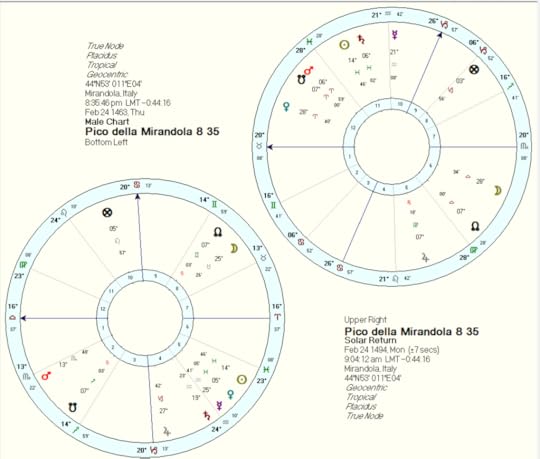
Pico was born on a Jupiter day during a Jupiter hour, so his profected Asc at age 31 is Taurus, which is on the 8th house cusp. Venus is therefore Lady of the year 1494, and in the birth chart she is square the lunar nodes (“at the bendings of the Moon”). With Taurus rising in the profected chart, the natal T-square involving Mars, the 8th house Moon, 4th house Saturn and the 12th house ruler Mercury is activated.
At age 31, his Lord/Lady of the Orb is Venus, which rules the 1st and 8th houses, again activating the Moon in the natal 8th. In the solar return, Venus occupies the 12th house and opposes the 6th house Moon very closely. The natal Moon occupies the 8th and rules the 8th by exaltation. Thus, as Lady of the Year, in 1494 CE Venus activates the 6th, 8th and 12th houses — a dangerous combination. The Venus-Moon opposition in the solar return makes a tight square to natal Jupiter in the natal 4th (endings), with Jupiter ruling the 8th house (death) of the retrun chart.
In addition, in the distributions (circumambulation) from the Ascendant of the natal chart, Venus is both divisor and participant from March of 1490 through June of 1495, as the directed Asc passes through the Venus term (bound) of Scorpio.
August 9, 2025
The Birth Chart of Charles I of Great Britain
Recently I’ve been rereading some old texts on my bookshelf. One of them is John Gadbury’s “The Nativity of King Charlres.” Gadbury begins by stating the birth data of the king but, as far as I can tell, he does not give the source of his information, which is quite precise: born on 19 November 1600 (OS), 29 Nov 1600 (NS), at 10h 2m 35s PM with the RA of the MC at 36:54 at geographic latitude 56 degrees. Stating the birth time to the second suggests that Gadbury must have rectified the chart. Sibly included a copy of Gadbury’s chart of King Charles I in his collection of notable nativities.
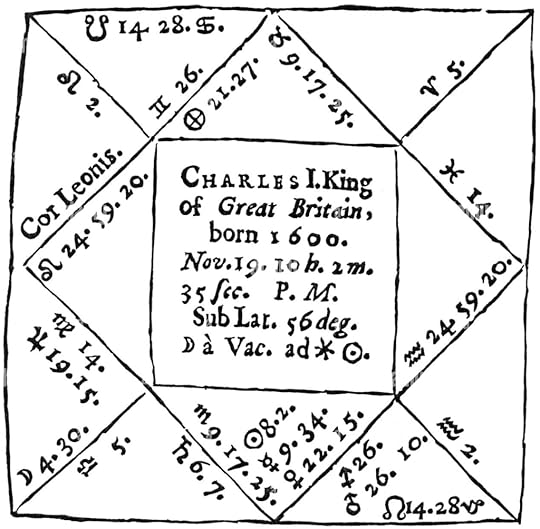 Gadbury’s version of the birth chart of King Charles I of England.
Gadbury’s version of the birth chart of King Charles I of England.
 Sibly’s reproduction of Gadbury’s chart of the birth of Charles I of Great Britain
Sibly’s reproduction of Gadbury’s chart of the birth of Charles I of Great BritainAstro.com notes the following about the source of the birth data of the king:
“Paul Wright quotes a letter from the English Ambassador to his Secretary of State, ‘On Monday last the King rode to the Queen to Dunfermline and returned yesternight. They never loved better. This night at 11 of the clock the Queen was delivered of a son and word therof this night at about three hours brought to the King.’ “
According to this quotation, Charles I was born during the 11th planetary hour after noon. Solar Fire calculates the planetary hours on the date of the king’s birth as follows:
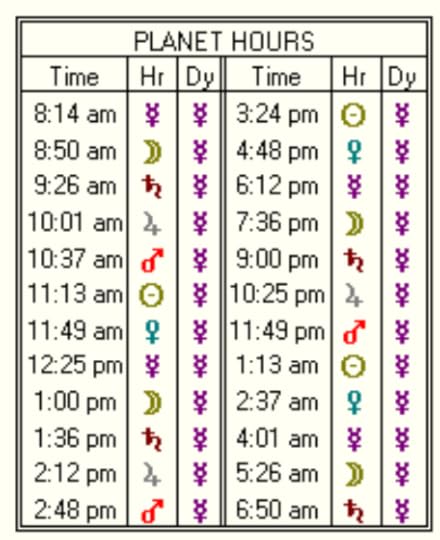 Planetary hours on the day and at the location of the birth of King Charles I.
Planetary hours on the day and at the location of the birth of King Charles I.In this table we see that the hour lord at Noon was Venus, and the 11th hour lord (PM) was Saturn, the 11th hour after Noon running from 9:00 pm to 10:25 pm, so Gadbury must have rectified the chart based on events in the king’s life to arrive at a birth time of 10:02:35 PM LAT, which falls roughly midway within the 11th hour’s time span.
On pages 86 to 89 of his book on the nativity of the king, Gadbury gives us hints as to how he did his rectification. He used the ancient “length-of-life” technique and looked for the hyleg (“hylech” in Gadbury’s text) in the king’s nativity. By Gadbury’s reckoning, the hyleg in this chart is the Ascendant. Other authors (Bonatti, Omar, Ptolemy, Lee Lehman) might have assigned the Part of Fortune to the role of hyleg in this nativity.
Gadbury would have looked below the horizon for a planet symbolizing a violent death. Mars in late Sagittarious stands out because Mars is a natural symbol of violent killing, part of Aries lies in the 8th house of death; and the ruler of the 8th cusp, Jupiter, forms a square aspect with Mars. Noticing that the dexter square of Mars lies in 26 Virgo in the 2nd house, Gadbury must have reasoned that an Asc degree which allowed 26 Virgo to rise to the eastern horizon in 48-degree arc of oblique ascension would be a reasonable rectified birth time. The king was hanged at 48.2 years of age.
Apparently, based on the single event of the hanging of Charles I, Gadbury produced a rectified chart with a precise birth time of 10:02:25 PM LAT. Generally, astrologers use multiple events in a person’s life to properly rectify a chart. Unfortunately, Gadbury’s ephemeris in the 17th century was not as accurate as a modern ephemeris, so his calculations are somewhat off. For example, Gadbury has Mars at 26 Sag 10′ but by modern calculations the King’s Mars at birth was at 25 Sag 11′ — a full degree earlier than the value used by Gadbury, suggesting an earlier Ascendant for the direction of the Asc to the dexter square of Mars to perfect at the time of the king’s demise.
 Modern calculation of King Charles I’s chart using Gadbury’s birth time.
Modern calculation of King Charles I’s chart using Gadbury’s birth time.Note the placement of Mars in the modern chart.
If we “rectify” the chart using the modern position of Mars, we find that the dexter square of Mars will rise to the eastern horizon on the day of his hanging if the rectified birth time is 9:55:47 PM LAT, which gives an MC of 7 Tau 47′ and and Asc of 23 Leo 56′. Based on modern positions of the planets, the “rectified” chart has a birth time about 6.5 clock-minutes earlier than the time Gadbury deduced.
Another issue with Gadbury’s calculations is that he may have been confused about the solar return for the year of the king’s demise. Charles I was 48.2 years old when he died. Calculating the solar return for the year of his hanging gives a solar return with an Ascendant in Aries. Gadbury, however, on page 86 calculated the Ascendant of the return to be in Pisces and the Dsc in Virgo. This may be a typo in Gadbury’s text, but he goes on to say that Pisces lies on the 8th cusp in the nativity and has moved to the Ascendant in the Solar Return, an indication of death in this year because the natal 8th house is rising in the return. The rest of the solar return looks correct, so Gadbury probably got confused and made a typo in drawing his chart, which he then interpreted as if it were true.
Here is the solar return generated by Gadbury’s original chart for King Charles I. Note that the Asc is 10 Aries, not 10 Pisces as Gadbury indicated in his text. Gadbury also noted that the Moon was about to perfect a lunar eclipse with the SR 8th house Sun within hours of the perfection of the solar return.
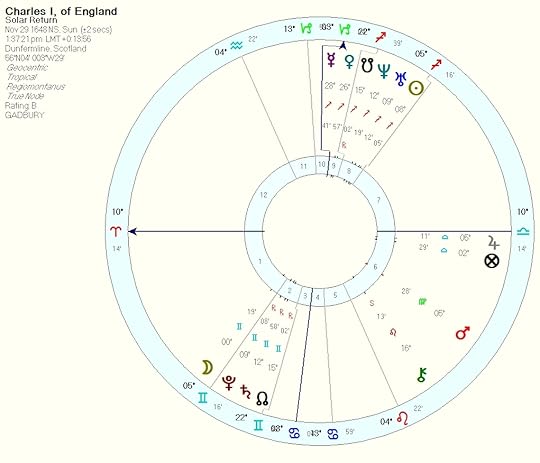 Solar Return for the year of the death of Charles I, based on Gadbury’s original birth chart for the king.
Solar Return for the year of the death of Charles I, based on Gadbury’s original birth chart for the king. Note the SR Sun on the cusp of the SR 8th house opposite the SR Moon and square SR Mars, and SR Jupiter (ruler of the natal 8th) conjunct the SR DSC and opposing the SR Asc. A partial lunar eclipse will take place within hours of the Sun’s return and will square SR Mars in the 6th — an ominous T-square configuration.
Finally, here is the Solar Return (inside) with the natal planets (outside) for the re-calculated “rectified” chart based on the modern calculation of the position of natal Mars (25 Sag 11′):
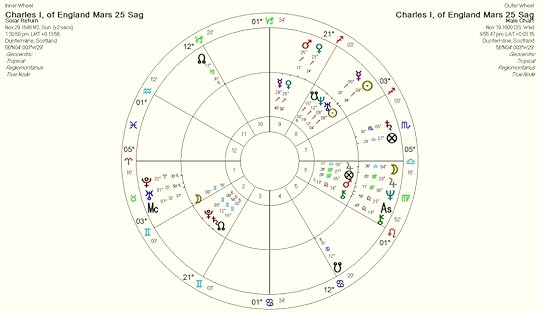 Using Gadbury’s method of rectification, I recalculated his chart for King Charles I, based on the modern position of Mars at 25 Sag 11′. Inside is the Solar Return for the year of the king’s hanging. Outside are the king’s natal planets.
Using Gadbury’s method of rectification, I recalculated his chart for King Charles I, based on the modern position of Mars at 25 Sag 11′. Inside is the Solar Return for the year of the king’s hanging. Outside are the king’s natal planets.In the king’s recalculated birth chart and solar return for the year of his death by hanging, SR Jupiter at 5 Libra opposes the SR Ascendant at 5 Aries. SR Jupiter is also conjunct the natal Moon.
Within a day of the exact solar return, a partial lunar eclipse fell across opposition between the stellium Pluto – Saturn – N.Node in the solar return 2nd and the stellium Sun – Uranus – Neptune – S.Node in the SR 8th, conjunct natal Sun and Mercury.
In May of 1649, within 4 months of the hanging in February of 1649 (NS), a total lunar eclipse took place at 5 Sag 02′, almost exactly on SR Jupiter and opposite the SR Asc.
Also in May of 1649, there was a partial solar eclipse at 21 Tau 09′ in the natal 10th house and square the natal horizon axis. The king was executed when the transiting Sun squared the position of this solar eclipse. Here is the chart of his hanging, according to Gadbury. Since it was a public event, I assume the time is fairly accurate.
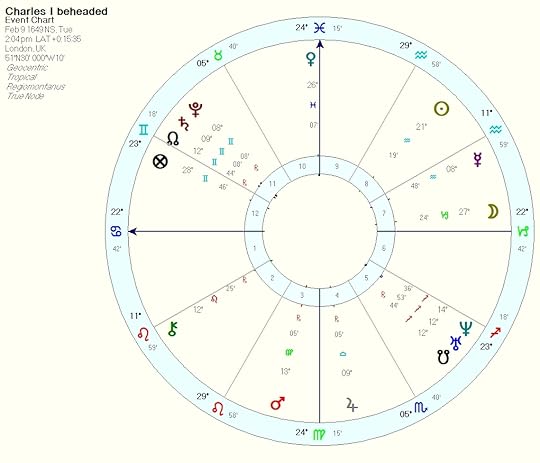 Gadbury’s chart for the hanging of King Charles I
Gadbury’s chart for the hanging of King Charles I
July 21, 2025
The Topocentric Moon in Primary Directions
In his writings on primary directions Martin Gansten notes that the use of the topocentric position of Moon provides a more accurate match in the timing of a direction of the Ascendant to the Moon than does the Moon’s geocentric position (Annual Predictive Techniques, p.71). When the Moon is near the horizon, parallax make a difference of up to one degree in the Moon’s zodiacal longitude, which can result in a difference of about a year in the timing of a direction involving the Moon and the Ascendant. Gansten, who uses the sidereal zodiac and the topocentric Moon, illustrates this finding with the birth chart (Chart G) of client whose academic career was refelcted in the primary direction of the Ascendant to the topocentric Moon.
I wondered how the chart and its directions would fare in the tropical zodiac with the geocentric position of the Moon. Gansten gives the birth data for Chart G as 29 May 1969, 16:21 CET, 55N35, 13E00 (Annual Predictive Techniques, p.212; he discusses the chart on pages 90-94.). Here is the chart in the tropical zodiac with Placidus houses and the geocentric Moon (whose topocentric position is 12 Scorpio 16′ — 00 degrees 47′ of arc greater than the geocentric position).
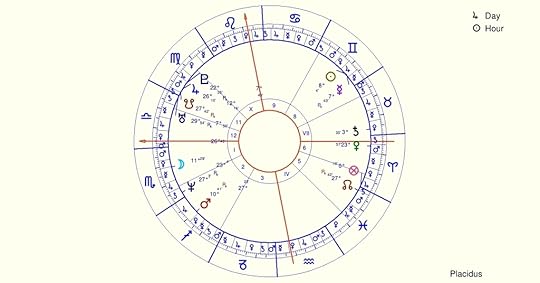 Chart G from Gansten’s Annual Predictive Techniques, p.91, cast here in the tropical zodiac with geocentric positions.
Chart G from Gansten’s Annual Predictive Techniques, p.91, cast here in the tropical zodiac with geocentric positions.The native of Chart G was born on a Jupiter day during a Sun hour. The Ascendant lies at 26 Libra 44′ and the MC at 7 Leo 48′.
Venus is the primary ruler of the Libra Ascendant. Venus lies in Aries, the sign of its detriment, where she conjoins the 7th cusp and opposes the Ascendant degree. Venus also rules Taurus, which is largely contain in the 7th Placidus house and occupies the 8th Placidus cusp.
Mars is dispositor of Asc-ruler Venus and, as such, is the secondary ruler of the Ascendant. Mars also rules the Placidus 7th and the Placidus 2nd house which Mars occupies. Mars mutually applies to oppose the MC-ruler Sun and 9th-ruler Mercury in the Placidus 8th house. Mercury is domicile lord of Gemini and exalted there, rules the 9th cusp, and is dispositor of the Sun and thus secondary ruler of the Midheaven.
The Moon, which is exalted in Taurus in the 7th and occupies the 8th cusp, lies in the 1st house in Scorpio, the sign of its fall. The Moon opposes Saturn in Taurus in the 7th of marriage and rules Cancer in the Placidus 9th house of higher education. The antiscia of the 10th-ruler Sun and 9th-ruler Mercury fall in the Jupiter term of Cancer in the 9th house, suggesting a strong professional interest in academic research and 9th house matters.
What do we know of the native of Chart G?
Gansten tells us that this is the nativity of a successful academic who graduated from university at age 29 and gained an academic appointment at age 29.5, some six months after graduation. With reference to primary directions, during this 6-month period the body of the topocentric Moon (with latitude) in the sidereal zodiac was crossing the eastern horizon with an arc of direction of approximately 29.25 degrees. My question is whether this academic success at age 29 is also symbolized in the geocentric chart with the tropical zodiac. Here is a list of primary directions calculated in Timaeus 9 Pro.
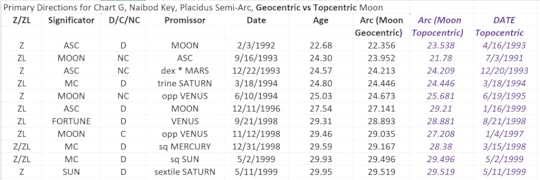 Z = zodiacal, ZL = zodiacal with latitude, D = direct, C = traditional converse, NC = neo-converse.
Z = zodiacal, ZL = zodiacal with latitude, D = direct, C = traditional converse, NC = neo-converse.Some key events in this person’s life, according to Gansten, include:
– Marriage at age 24. This correlates with the neo-converse direction of the Moon to the Ascendant at age 24, the geocentric Moon ruling Taurus in the 7th by exaltation and being disposited by Mars, ruler of the 7th. In addition, there is a neo-converse direction of the Asc to the dexter sextile of 7th-ruler Mars occurs at this age, and the MC is directed to the sinister trine of 7th-house Saturn. Thus, he has three directions which indicate marriage perfecting at age 24.
In addition, at age 24 he was in a 1st house Libra profection year and Venus was Lady of the Year, accompanied by Saturn as Lord of the Orb. Venus conjoins the 7th cusp and Saturn in Taurus, ruled by Venus, occupies the 7th house. Venus is a natural signifier of marriage, and Saturn is a symbol of commitment and responsibility.
– Graduation from university at age 29 (?June 1998?). This correlates with the direction of the Lot of Fortune to Venus, both of which have Mars as their dispositor, with Mars closely applying to trine the MC and opposing the Sun, ruler of the MC.
– Obtaining an academic position at age 29.5 (?December 1998?). This correlates well with the direction of the Asc to the topocentric Moon in January of 1999. This period of academic succes is 1998 also correlates well with the MC directed to the square of Mercury, which rules the 9th of universities and conjoins the 10th-ruler Sun (career) in the 8th of in-depth research.
– Breakdown of his marriage and separation from his wife at age 34. The reader may wish to study the primary directions for this and the following periods. The potential for maritial separation is indicated in the birth chart by the location of Venus in Aries, the sign of its detriment; the retrograde motion of 7th-ruler Mars; and the 1st house Moon in Scorpio, the sign of its fall, opposing Saturn in Taurus in the 7th.
– Completion of a Doctorate at age 34. (A Leo annual profection year ruled by the Sun, with Mars as Lord of the Orb.) On 4/28/2003, the MC perfected a direction to the dexter sextile of the topographic Moon without latitude. The Moon rules Cancer in the 9th house of the tropical chart.
– Receipt of a major 3-year research grant at age 35. (A Virgo annual profection year ruled by Mercury in Gemini in the 8th and the Sun as Lord of the Orb.)
– Passing of his father at age 46. (A Leo annual profection year ruled by the Sun, with 4th-ruler Saturn as Lord of the Orb.) On 1/20/2016 (age 46) the Asc perfected a neo-converse direction to Jupiter (withou latitude). Jupiter conjoins the South Lunar Node, occupies the Placidus 11th house of the death of a 4th-house parent, and rules the 3rd cusp, which is the 12th of undoing of the 4th-house parent.
It does appear that the topocentric position of the Moon is useful in primary directions, but the geocentric position also provides valid information.
July 10, 2025
The Sun-Earth Perihelion Chart in Mundane Astrology
Recently I read a post on Facebook by astrologer Ed Kohout about the use of the Sun-Earth Perihelion chart in mundane astrology. It’s not a technique that I have used before, so I decided to take a look and attempt a brief mundane delineation for our nation for the year 2025 based on the perihelion chart.
Perihelion occurs when Earth is closest to the Sun, which happens in early January about two weeks after the December solstice. This year (2025) the Earth reached perihelion, its closest point to the Sun, on 04 Jan 2025 at 8:28 AM EST, when the Earth was separated from the Sun by a mere 91,405,993 miles (147,103,686 km) as opposed to its average distance of 94.5 million miles. The dates and times for the Earth-Sun perihelion are listed in EST (Eastern Standard Time) at this website: https://www.farmersalmanac.com/aphelion-and-perihelion. Here is the 2025 chart with Placidus Houses cast for Washington, DC.
 2025 Perihelion Washington, DC
2025 Perihelion Washington, DCTo interpret this as a mundane chart, we can use these traditional significations of the HOUSES:
1st House: National condition, overall prosperity and health of the country and its people.
2nd House: National wealth, treasury, banks, financial institutions, and economic trade.
3rd House: Transportation, communications, media, neighboring countries.
4th House: Land, agriculture, buildings, the common people vs. aristocracy, weather patterns.
5th House: Entertainment, culture, birth rates, children, sports, high society, ambassadors.
6th House: Public health, military services, civil service, workers, trade unions.
7th House: Foreign relations, international affairs, national marriage/divorce rates.
8th House: National mortality rates, death duties, international financial relations.
9th House: International transport, religion, higher education, law courts, long-distance communications.
10th House: Government leadership, national reputation, famous persons, public employment.
11th House: Parliament, legislative bodies, national allies, legislation.
12th House: Prisons, hospitals, welfare institutions, secret enemies, hidden threats.
The PLANETS mundane astrology have general significations which may apply, but they must especially be interpreted with reference to their house placement and rulership in the mundae chart.
Sun: Government leaders, monarchy, aristocracy, judges, authority figures, national heroes.
Moon: Common people, women, crowds, public opinion and attention.
Mercury: Media, communications, trade, commerce, intellectuals, local transport.
Venus: Women’s issues, birth rates, arts, entertainment, peace, diplomacy.
Mars: The military, war, conflicts, strikes, fire services, opposition forces.
Jupiter: Religion, justice system, national wealth, banks, prominent judges.
Saturn: The elderly, death rates, epidemics, agriculture, mining, public sorrow.
Uranus: Political unrest, right-wing politics, individualism, scientific breakthroughs, explosions.
Neptune: Left-wing politics, socialism, collectivism, fraud, secret plots, illicit activities.
Pluto: Transformation, hidden power, espionage, organized crime, underground activities.
POTENTIAL DELINEATION OF THE MAJOR FEATURES OF THIS MUNDANE CHART FOR THE USA IN 2025
In this mundane astrology chart, having Pluto angular on the eastern horizon (rising/ascendant) and Mars angular on the western horizon (setting/descendant) creates a powerful axis of transformation and conflict that has significant implications for the nation:
Pluto Rising (Eastern Horizon/Ascendant)
Based on the mundane meanings, Pluto represents “metamorphosis and regeneration” and rules “all aspects of life that are carried on in the dark or hidden from public view — political undergrounds, espionage, organized crime. Great wealth and power. Violence, rape. All activities that are transformative (like death and rebirth) or that bring hidden information to light (such as detective work).”
With Pluto rising, this suggests:
The nation itself is undergoing fundamental transformation, especially with regard to the “overall prosperity and health of the country and its people.”
Hidden power structures or corruption may be exposed.
Underground or covert activities become prominent national issues.
The country’s identity and reputation may be linked to transformative events.
Regeneration and rebirth themes dominate the national consciousness.
Mars Setting (Western Horizon/Descendant)
Mars governs “the military, soldiers and noted military and naval men. War, terrorist attacks, industrial disputes, strikes and conflicts. Opposition forces. Fire, fire services, arson and incendiarism.”
With Mars on the descendant (7th house cusp), this indicates:
Military issues or conflict with foreign nations and neighboring countries (Mars rules the 3rd cusp — neighbors).
External opposition forces or enemies.
International disputes or tensions.
The nation may be seen by others as aggressive or militaristic.
Foreign affairs dominated by conflict or military considerations.
The Pluto-Mars Opposition Across the Horizon creates a powerful axis where:
Internal transformation (Pluto rising) meets external conflict (Mars setting).
The nation undergoes deep internal change while facing external military or conflict/aggression challenges.
Hidden power struggles within the country may manifest as international tensions.
The process of national transformation may provoke or attract foreign opposition.
The country’s regeneration period coincides with heightened international military concerns.
This Pluto-Mars-horizon configuration suggests a year during which the nation will experience profound internal change while simultaneously dealing with significant external conflicts or military challenges — a time of both national metamorphosis and international tension.
In a mundane astrology chart, Uranus angular on the 4th house cusp (IC) and stationary direct creates a highly significant and volatile configuration for the nation:
Uranus represents “rioting and outbreaks of political tension. Right-wing political ideas, free-market enterprise, fascism, and the urge towards individualism. It rules separation, scientific breakthroughs and discoveries, explosions, anarchy and nihilism.”
The 4th House governs “Land, the owners of it and the workers on it. The crops and produce of the land. Mines, buildings. The people as contrasted with the monarch; the democracy as contrasted with the aristocracy; the opposition in Parliament.”
Being angular dramatically amplifies Uranus’s influence. The IC represents the foundation, roots, and deepest core of the nation. This placement suggests:
Fundamental upheaval in the nation’s foundation and infrastructure.
Popular uprising or revolutionary sentiment among the common people.
Sudden unanticipated disruption to agriculture, land use, or property ownership.
Political rebellion against established authority (opposition to the 10th house government).
Explosive changes in housing, real estate, or national infrastructure.
Technological revolution in agricultural or mining sectors.
Stationary Direct Motion of Uranus:
When a planet is stationary, its energy is highly concentrated and powerful. Stationary direct means Uranus is about to resume forward motion after a retrograde period, suggesting:
A breaking point reached — revolutionary energy that has been building internally now bursts forward.
Sudden breakthrough or dramatic change in the areas Uranus governs.
Maximum intensity of Uranian energy affecting the nation’s foundational structure.
Irreversible change — the stationary direct motion suggests that there is no going back.
The Combined Interpretation of the influences suggests:
Revolutionary upheaval from the grassroots level.
Sudden, unexpected and/or dramatic changes to the nation’s fundamental structure.
Popular rebellion or mass movements challenging the established order and prior status quo.
Explosive developments in domestic policy or internal affairs.
Technological or scientific breakthroughs that transform the nation’s foundation.
Separation or independence movements gaining momentum.
Infrastructure disruption — sudden changes to transportation, utilities, or basic services.
The stationary direct motion of Uranus suggests this isn’t gradual change but a sudden, powerful release of revolutionary energy that fundamentally alters the nation’s domestic foundation and relationship between the people and their government.
In a mundane astrology chart, Mars in Leo ruling the 10th cusp in Scorpio creates a fascinating dynamic between the ruler and the house it governs:
Mars in Leo
Mars represents “the military, soldiers and noted military and naval men. War, terrorist attacks, industrial disputes, strikes and conflicts. Opposition forces.”
In Leo, Mars takes on solar qualities — theatrical, dramatic, proud, and seeking recognition.
This suggests:
Military leadership that is bold, dramatic, and seeks glory.
Conflicts that are highly visible, dramatic and theatrical in nature.
Opposition forces that are charismatic and attention-seeking.
Industrial disputes with dramatic, public confrontations.
Fire services that gain prominence or recognition.
10th House Cusp in Scorpio
The 10th House governs “The monarch or president, the government, people in authority. Royalty, eminent and famous persons. National trade. The national reputation, credit, and power.”
In Scorpio, the government and national leadership take on Scorpionic qualities:
Secretive, intense leadership style.
Government operating through hidden power.
National reputation based on mystery, depth, or transformation.
Authority figures who are magnetic but potentially ruthless.
National power exercised through covert or behind-the-scenes methods.
Scorpio is often associated with intense emotions and a strong sense of loyalty, which can manifest as a tendency to hold grudges and seek retribution when wronged.
Mars in Leo Ruling Scorpio 10th House creates a compelling contrast:
Public Mars energy (Leo) governing hidden governmental power (Scorpio).
Dramatic, attention-seeking military/conflict energy directing secretive leadership.
Bold, theatrical opposition forces challenging mysterious government authority.
Visible military leadership serving covert governmental agendas.
Practical Manifestations
This configuration suggests:
Military leaders who are charismatic and public-facing, but serving a secretive government agenda.
Government authority that operates through hidden or secretive channels while military/conflict issues dominate public attention.
National reputation built on both dramatic military prowess and mysterious political power.
Leadership style that combines theatrical public presence with intense, secretive decision-making.
Opposition forces that are bold and attention-grabbing, challenging a government that prefers to operate from the shadows.
The tension between Leo’s need for recognition and Scorpio’s preference for secrecy suggests a government that must balance public military/conflict visibility with private, intense power dynamics — potentially creating internal stress between what the public sees and how power actually operates in secret.
In this mundane astrology chart, the Moon-Saturn conjunction in the 1st house in Pisces, with Saturn ruling the Ascendant creates a profoundly significant and challenging configuration for the nation:
Moon-Saturn Conjunction in Pisces
The Moon represents “the common people, women generally, crowds, and all matters of a common or public nature.”
Saturn “has chief influence over elderly people and governs the national death rate. Life-threatening epidemics. Land-owners, farmers, mines, coal and industries connected to metals and minerals. State funerals, public sorrow and disappointment.”
In Pisces, this conjunction takes on qualities of:
Emotional suffering and sacrifice.
Collective grief and compassion.
Dissolution of boundaries.
Spiritual or idealistic responses to hardship.
1st House Placement:
The 1st House represents “The country and its inhabitants as a whole; its general condition of prosperity and health or the reverse.”
This placement directly affects the nation’s fundamental identity and overall condition.
Saturn Ruling the Ascendant
With Saturn as the chart ruler, Saturn’s influence dominates the entire chart and national identity.
The nation’s core identity is shaped by collective sorrow and hardship.
Economic depression or widespread suffering defines the national character.
The country experiences chronic challenges affecting its basic prosperity and health.
National mood is somber, restricted, and burdened in 2025.
The People’s Experience:
Common people face significant hardships, restrictions, and limitations.
Elderly population becomes a central national concern.
Women and families bear the burden of national difficulties.
Public attention focuses on survival, basic needs, and collective suffering.
Manifestations:
Economic recession and financial hardship affecting the general population.
Health crises or epidemics impacting national well-being.
Agricultural difficulties or food security issues.
Industrial decline or mining/resource extraction problems.
National mourning or collective grief over losses.
Increased death rates or life-threatening conditions.
Piscean Influence:
The nation may respond to hardship with compassion and spiritual resilience.
Collective sacrifice for the greater good.
Dissolution of previous structures leading to confusion but also potential renewal.
Idealistic or spiritual movements arising from suffering.
This configuration suggests a nation undergoing a fundamental crisis of identity through collective hardship, where the people and government face serious challenges to basic prosperity and wellbeing, but with potential for spiritual growth and compassionate response through shared suffering.
July 6, 2025
Marriage and the 9th House in Astrology
Astrologers generally associate marriage as a legal contract with the 7th House, its ruler and occupants, and the planet Venus. Over the years I have noticed that the 9th, the House of God, and its ruler and occupants are very often active in charts at the time of marriage. This may be because traditional marriages often involve a religious or church ceremony, representing a spiritual covenant (sacred vows) between the individuals entering into matrimony.
In the Catholic Church, for example, marriage is cosidered a sacrament which the Catechism explains as follows: “The sacrament of Matrimony signifies the union of Christ and the Church. It gives spouses the grace to love each other with the love with which Christ has loved his Church; the grace of the sacrament thus perfects the human love of the spouses, strengthens their indissoluble unity, and sanctifies them on the way to eternal life.”
The 9th House is also the derived 3rd House of the kin of one’s partner and is the “joy” of the Sun-god, a house of luck and good fortune. Weddings typically involve one’s own extended family and the participation of the relatives of one’s spouse. Hindu astrologers often associate the 9th house with a second marriage, the first one belonging to the 7th house.
Recently I watched a video by Alexey Borealis in which he uses the predtictive techniques of Morinus to forecast the date of marriage of the native, a woman born on 4 April 1988 at 6:46 AM in Moscow. Here is her natal chart with Placidus houses.

This woman was born on a Sun day during a Mercury hour. It is a preventioal chart (Moon is waning) and the SAN (prenatal lunation) is at 12 Libra 51′. The Hyleg according to Ptolemy’s method is the Moon.
The native’s traditional signifiers are:
– Aries Asc ruler Mars by domicile.
– Aries Asc ruler Sun by exaltation. The Sun is applying very closely to the 9th Placidus cusp of the house where Sol rejoices, indicating a favorable connection with the House of God and, among other things, religious ceremonies and rituals, such a marriage.
– Sun exalted in Aries in the 1st.
– Jupiter in Taurus in the 1st.
– Moon in fall in Scorpio in the 7th, accidental ruler of the 1st by opposition (according to Morin).
Signifiers of marriage include:
– Libra Dsc ruler Venus by domicile.
– Libra Dsc ruler Saturn by exaltation. Saturn is quite strong in this chart, being in the angular 10th and conjunct the MC. Saturn is also quite dignified, occupying its domicile Capricorn. Saturn is also in a favorable trine with Jupiter in Taurus in the 1st house. The positive condition of Saturn in the chart promises marriage for this native at some time in her life.
– Moon in fall in Scorpio in the 7th.
– Mars as co-ruler of Scorpio, largely contained in the 7th.
When is she likely to marry? We can get a rough estimate by eyeballing the chart. Unlike Morin, for directions I prefer the Ptolemaic method of proportional semi-arc.
Venus, ruler of the 7th cusp, lies at 0 Gemini 23′ early in the 2nd house. The Asc is at 5 Aries 09′.
The Ascensional time of Aires is 10.57 equatorial degrees, and that of Taurus is 14.63 equatorial degrees. Since 5 degrees of Aries has already risen, 25 degrees remain to rise. 25/30 x 10.57 = 8.81 equatorial degrees.
Thus, 8.81 Eq. degrees of Aries + 14.63 Eq. Degrees of Taurus = 24.4 Eq degrees that need to rise for the projection of the body of Venus onto the ecliptic to reach the eastern horizon. At Ptolemy’s rate of one degree = one year of life, we estimate that she might marry around 24 to 25 years of age.
Saturn, ruler of the 7th cusp by exaltation, is closely conjunct the MC. Mars rules the 1st cusp and lies 26.07 degrees away from Saturn on the ecliptic. Because Saturn is so close to the meridian we can estimate the primary direction of Saturn to Mars by finding the difference in their Right Ascensions.
RA of Mars = 300.42 Eq. degrees
RA of Saturn = 272.70 Eq. degrees
Difference in RA = 27.72 Eq. degrees = 27.7 years old by Ptolemy’s key.
If we calculate the direction of Saturn to Mars by proportional semi-arc with 0 latitude, we get an age of 27.4 years with Ptolemy’s key.
Doing this calculation, we also find that the sinister sextile (at 2 Pisces 30′) of Saturn, will be carried by primary motion to Mars at age 25.5 by Ptolemy’s key with 0 latitude.
So far we have found three primary directions that could signify marriage between ages 24.4 and 27.4. We can use profections and distributions from the Hyleg to further refine the timing.
AgeLord of YearLord of OrbDivisor from Moon & Participant24Mars (Aries activates the Sun)JupiterVenus (opp. Venus)25Venus (Taurus activates Jupiter)MarsVenus (opp. Venus) 26 Mercury (Gemini activates Venus)SunVenus (trine Sun, Aug.)27Moon (Cancer)VenusVenus (trine Sun)28Sun (Leo)MercuryVenus -> Mercury(trine Sun)
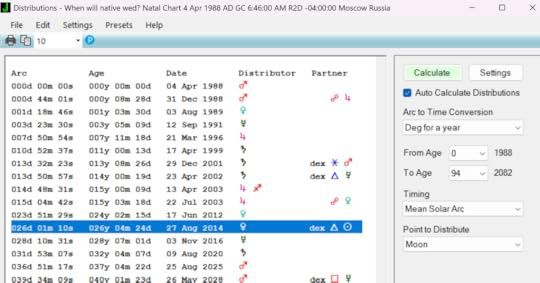
The distributions from the Moon (hyleg according to Ptolemy) suggest that the period after August 2014 and before November 2016, when the Divisor is Venus (lord of the 7th) and the Participant is the Sun (exalted in the 1st and exalted ruler of the Asc), is highly favored for a marriage. The Sun is Lord of the Orb at age 26, signifies both the native by occupying the 1st huse and the marriage by its opposition to the 7th house, and is trine the 9th cusp of the joy of the Sun, making age 26 a highly likely period for a wedding involving a religious ceremony.
Because eclipses tend to highlight important events according to the houses they fall into, I would next consider solar and lunar eclipses during the period from August of 2014 to November of 2016, which was indicated by the distributions from the Moon. The most impressive hit is the total lunar eclipse of 8 October 2014 which occurs at 15 Aries 05′ closely conjunct this woman’s natal Sun at 14 Aries 33′ in the 1st house, ruling her Ascendant by exaltation and closely trine her Placidus 9th house cusp which lies in the terms of Venus in Sagittarius. A couple weeks later on 23 October 2014 a partial solar eclipse occurs in the first degree of Scorpio, close to the Moon in the 7th house of marriage.
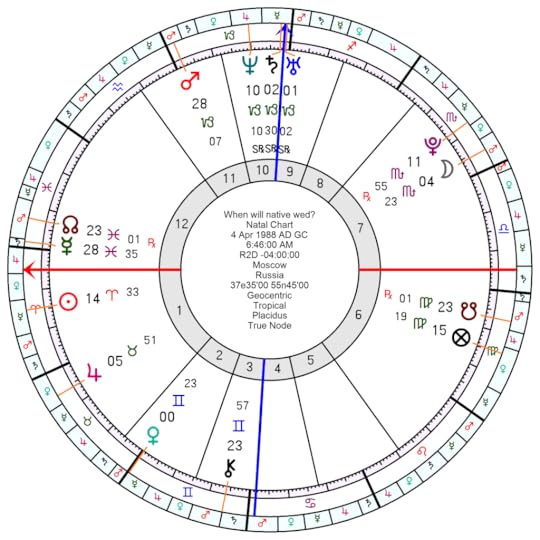
Morin would next study the solar returns for the period from about age 24 to age 27 to determine which solar return was most similar to the primary directions of the period indicating a marriage. Having identified the most likely year, Morin would further refine his timing by studying the lunar returns and transits that most closely indicated when the wedding was likely to occur.
The native of this chart married on 24 Octobe 2014, one day after the solar eclipse conjunct her natal moon in the 7th house. I don’t know whether it involved a religious ceremony.
June 28, 2025
Primary Directions and President Trump’s Forecast
Recently I read Aleksey Borealis’ article in APAI Chronycle on Trump’s astrological forecast for 2025-2026 based on the primary directions of his birth chart which are active during this period. Alexey does a fine job explaining his reasoning and reaching conclusions about what may lie ahead for the president. His method is based on the teachings of Morin de Villefranche regarding determination and the method of directing advocated by Regiomontanus in the 15th century and further refined by Morinus in the 17th century.
After reading the article, I wondered how the forecast might differ if it were based on the 2nd century method of directing proposed by Claudius Ptolemy and popularized by Alcabitius (al-Qabisi) in the 10th century and by Placidus in the 17th century. The astrological reasoning would be the same but the timing would be different because Regiomontanus calculated directions on the basis of his own method of Circles of Position, whereas Ptolemy based his directions on temporal hours and proportional semi-arcs. Ptolemy would have regarded the Regiomontanus Circle of Position timing as an approximation of the timing provided by proportional semi-arc (that is, the proportional number of equinoctial times that bring to promissor to the significator).
Placidus defined Circles of Position differently than Regiomontanus, basing them on the planet’s bodily position and the point on the Celestial Equator proportional to the planet’s position on its semi-arc in that quadrant. Gansten notes that the Placidus method of “directions under the pole of the significator, generally gives dates within a few months of the Ptolemaic method (but may differ from the Regiomontanian by several years).” — Gansten, Primary Directions, pp.93-94.
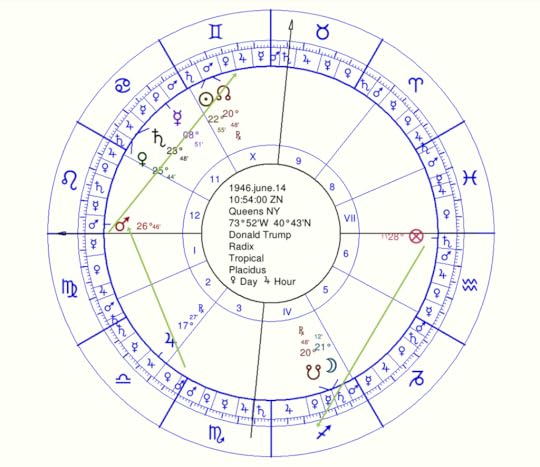 Donald Trump’s birth chart. Green arrows are the directions under consideration.
Donald Trump’s birth chart. Green arrows are the directions under consideration.Aleksey studies three distinct Regiomontanus directions:
1) The Part of Fortune (significator) directed to the favorable sinister sextile of Jupiter (promissor) in October of 2024. This is a traditional converse direction because the primary motion of the sky carries the significator Fortuna to the sinister sextile of Jupiter, an aspect of Jupiter (promissor) which lies in Sagittarius (the domicile of Jupiter).
The equivalent Ptolemaic direction (Naibod rate, 0 latitude) would perfect on 25 Nov 2023; with latitude, on 22 June 2023; in Bianchini circle of aspects, on 8 Sep 2023. Thus, the Placidean direction perfects about a year earlier than the equivalent Regiomontanus direction.
2) Mars in late Leo, as significator, is directed to the sinister sextile of Mars, an aspect in late Libra (the exile of Mars) which acts as promissor. This is also a traditional converse direction because the primary motion of the sky carries the sinister sextile aspect of Mars, as promissor, to the body of Mars (significator). This aspect perfects in April of 2025.
The equivalent Ptolemaic direction (Naibod rate, 0 latitude) would perfect on 11 Sep 2022; with latitude, on 20 Aug 2022; in the Bianchini circle of aspects, on 28 Nov 2022. Thus, the Placidean direction perfects almost three years earlier than the equivalent Regiomontanus direction and would correspond to the trouble Trump got into with the United States govenment because he took top secret documents with him to his residence in Florida after he left office.
3) Finally, the Degree of the Ascendant as significator is directed to the dexter trine of Jupiter, an aspect in Gemini in the 10th house, which acts as promissor. This is another traditional converse direction because the primary motion of the sky carries the Asc Degree (as significator) to the Gemini trine of Jupiter which occupies the sign of exile of Jupiter. This aspect perfects in August of 2026.
The equivalent Ptolemaic direction (Naibod rate, 0 latitude) would perfect on 12 Sep 2025; with latitude, on 14 Feb 2026; in Bianchini circle of aspects, on 26 June 2025 (coincidenatlly, the time of the writing of this post). Thus, the Placidean direction perfects within a year of the equivalent Regiomontanus direction.
We see in this example that the two most commonly used methods of primary directing (Ptolemy/Placidus and Regiomontanus) are sometimes close in timing but can differ by several years.
June 21, 2025
Traditional vs Modern Neo-Converse Directions
Primary directions were the mainstay of astrological forecasting for many centuries before the modern era. The underlying idea is simple. The positions of the natal chart are indelibly projected onto the Celestial Sphere at birth — a kind of 3-dimensional snapshot of the birth chart. The planets and certain key points of the natal chart serve as significators of areas of life. An exact copy of the projection of the natal chart cast onto the Celestial Sphere is imagined to rotate around itself by the primary motion of the sky during the 24 hours after birth. Alignments of the natal positions on the two identical spheres occur during this rotation. The timing of these alignments of rotating promissors to stationary significators indicates when the natal promise is likely to manifiest in the life of the native.
In the standard model, promissors are carried clockwise by primary motion to significators in the birth chart. These are called “direct” primary directions. Sometimes, however, a promissor (say, a planet in the 9th house) lies earlier in the zodiac than a significator (say, the MC — one’s actions in the world), and we want to know how to convert the arc between the promissor and the significator into a date on the life course of the native.
The traditional solution was to hold the sphere of promissors steady and let the sphere of significators rotate until the significator alligned with the promissor by direct primary motion. These were called “converse” directions, and their basis was still direct primary motion of the sky after birth.
Another solution is the imagine the sky rotating backwards (and time flowing backwards) so that the promissor moves backward in time until it reaches the significator; in our example, the 9th house promissor moving backward (counterclockwise) until it has alligned (at some time in the past) with the MC as significator. Modern astrologers also call such directions “converse” but they are converse in a different sense than in the traditional model. A better term would be “neo-converse,” as such directions are labeled in the program Delphic Oracle. In fact, Delphic Oracle clearly labels directions as direct, traditionally converse, and neo-converse. Let’s look at an example.
AstroDataBank includes the chart of
NameHammer, Kristina Gender: FBirthnameHammer, Kristina Leighborn on2 November 1979 at 21:11 (= 9:11 PM )PlaceWeymouth, Massachusetts, 42n13, 70w56TimezoneEST h5w (is standard time)Data sourceQuoted BC/BRBIO: “American accident fatality; a Halloween tragedy, she died two days before her 14th birthday. An all-star town league softball player, responsible and intelligent, she was out with a group of her friends for trick-or-treating, dressed as a doll for Halloween.
About 20 minutes after leaving her house, she dashed ahead of her friends to cross the street, was hit by a car and killed instantly on 31 October 1993 at 4:54 PM EST, Middleboro, MA. The driver was within the legal speed limit and was not cited. All ten kids had flashlights and bright clothes on at the time of the tragedy.”
Here is her tropical zodiac birth chart (Rodden rating AA) with Placidus houses, true lunar nodes, the “modern” planets (Uranus, Neptune, and Pluto), and Chiron, which I find is usually quite active in cases of bodily injury:
 Hit by a car and killed instantly on 31 October 1993 at 4:54 PM EST, Middleboro, MA.
Hit by a car and killed instantly on 31 October 1993 at 4:54 PM EST, Middleboro, MA. She was born on a Venus day during a Moon hour, although if she were born 2 minutes earlier the hour lord would have been Mercury.
To begin, we look at the birth chart to see whether a violent accidental death is contained within the natal promise.
With Cancer (a cardinal water sign) rising, her primary Asc-ruler is the Moon in Aries (a cardinal fire sign) in the angluar 10th house. The Moon’s closest aspect is a separating quincunx from 8th-ruler Saturn, which occupies Virgo in the radical 3rd house (local travel). The quincunx has 6th and 8th house connotations. With Saturn ruling the 8th cusp and being tied to the 10th house Moon by quincunx and the the Asc degree by sextile, the native’s death is linked closely to her own actions in the world. Saturn is also square to Neptune in Sagittarius on the cusp of the 6th, suggesting the potential for life-threatening bodily injury due to inattention or carelessness. The potential for violence is shown by the 4th house (of endings) Pluto opposing the Moon and squaring the Ascendant degree. Pluto is also connected to the Moon’s dispositor Mars by a sextile from Libra, the sign of detriment of Mars.
The secondary ruler of the Ascendant is Mars (ruler of Aries and dispositor of the 10th house Moon). Mars occupies Leo (a fixed fire sign) and lies in the 2nd house of income and accidentaly the house of the native’s death due to the opposition of the body of Mars to the radical 8th house. Mars (accidental ruler of the 8th) is separating from a close square to Uranus (sudden unexpected events) in Scorpio in the 5th of fun and recreational activities. Mars square Uranus is common in cases of vehicular accidents. Secondary Asc ruler Mars is disposited by the Sun in Scorpio (the sign of fall of the Moon) on the cusp of the 5th house. The Sun applies to square the 8th cusp within 2 degrees and mutually applies to oppose Chiron (bodily injury) in about 1.5 degrees. We should pay special attention to Mars square Uranus, Sun oppose Chiron, and Saturn square Neptune (on the 6th cusp) as indicators of potential serious bodily injury due to an accident.
The planet Jupiter, being exalted in Cancer, also rules her Ascendant by exaltation. Jupiter lies in Virgo (the sign of its exile) and in the 3rd house (local travel). The dispositor of Jupiter is Mercury, which lies in Sagittarius in the 5th house of fun activities. Mercury applies to square detrimented Jupiter, which rules the 6th of bodily injury and the 9th and occupies the 3rd.
The Ascendant is also conjunct the fixed star Pollux, which Morin regarded as a violent star.
Next we try to identify which periods in her life this natal promise is likely to manifest. We can do this by eyeballing the chart, looking for the natal planets being carried clockwise by primary motion to an Angle or a House Cusp. In this chart, the first “hit” by clockwise motion appears to be Mars moving the the cusp of the 2nd house in about 10 ecliptic degrees, followed by the zodiacal position of Pluto moving to the IC in about 16 ecliptic degrees.
In primary directing we work with arcs on the equator rather than the ecliptic, so we need to convert these ecliptic arcs to time periods in the native’s life. For Pluto (whose arc to the IC is about 16 ecliptic degrees) it’s quite easy since Pluto is moving toward the IC. We just look up the Right Ascension of the IC and of the zodiacal degree of Pluto (without latitude) and subtract:
IC has RA of 183:33
Pluto’s zodiacal degree has RA of 198:26
The difference is RA of 14:53, so there is risk of a serious accident around age 14, close to age 15.
Mars has a smaller arc to travel along the ecliptic to reach the 2nd house cusp. Because these are intermediate points between the horizon and merician, we need to use proportional semi-arc. Here, we can use the “chart animate” feature of softward to estimate the timing. She was born at 9:11 pm, and Mars reached the cusp of the 2nd Placidus house at 9:58:20 pm, the difference being 47 minutes 20 seconds. Since the MC advances by about one degree a little less than every 4 minutes, we divide 47 minutes by a little less than 4 and get the result of about age 12.
Working now on the Equator, we see that the native is at risk of a life-threatening accident or injury between ages 12 (when Mars crosses the 2nd cusp) and 15 (when Pluto without latitude crosses the IC). Further, using our animate chart option we see that 8th ruler Saturn exactly quincunxes the 8th cusp at 10:06 pm, which is 55 minutes after birth. Dividing 55 minutes by a little less than 4 minutes give the result of about 13.98 years old (Saturn quincunx 8th cusp by primary motion).
So far we have deduced from the natal promise and the earliest primary directions to the chart’s Angles and House cusps that there is a risk of a serious bodily injury or accident between ages 12 and 15, with a peak period close to age 14.
Next, we look at annual profections to see at which of these ages an accident is most likely.
At age 12 she is in a 1st sign Cancer/1st house profection, and her Lady of the year is the Moon.
At age 13 she is in a 2nd sign Leo/2nd house profection; her Lord of the Year is the Sun, and Mars in Leo is activated by occupying the profected Ascendant. This is a high risk year because natal Mars square Uranus is activated simultaneously with Sun oppose Chiron at age 13.
At age 14 she is in a 3rd sign Virgo/3rd hose profection. Her Lord of the Year is Mercury, and Jupiter and Saturn in Virgo are activated. This year has moderate risk of an accident but not as pronounced as the risk at age 13.
We can next ask whether the method of circumambulation through the bounds agrees with age 13 as a highly riskly year. By Ptolemy’s reckoning, the Moon takes on the role of hyleg, symbolizing the life force in this chart. Using Janus 6 software, I determined to the distributions to be:
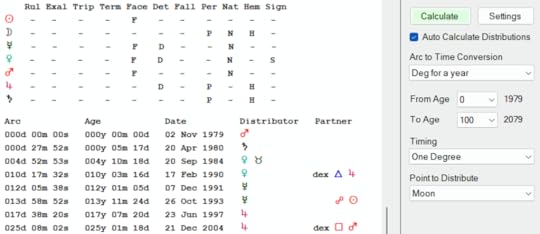 On October 31, 1993 (the day of the accident) her “divisor” or “distributor” was Mercury because the directed ASC was passing through the Mercury Term (Bound) of Taurus which was receiving the opposition aspect from the Sun (partner to the division lord), as of October 26, 1993 (just 4 days prior to the accident). Natal Chiron was occupying the Mercury term of Taurus, so that the natal Sun opposition Chiron aspect was also being activated. The primary direction of Saturn to the 8th house cusp was also perfecting in late October of 1993.
On October 31, 1993 (the day of the accident) her “divisor” or “distributor” was Mercury because the directed ASC was passing through the Mercury Term (Bound) of Taurus which was receiving the opposition aspect from the Sun (partner to the division lord), as of October 26, 1993 (just 4 days prior to the accident). Natal Chiron was occupying the Mercury term of Taurus, so that the natal Sun opposition Chiron aspect was also being activated. The primary direction of Saturn to the 8th house cusp was also perfecting in late October of 1993.Now let’s look at the primary directions for this period, as calculated in Delphic Oracle software.

At age 13 (birthday 2 Nov 1992) the first direction she experiences is Mars to the square of Mercury, which perfects on 8 Nov 1992, just 6 days after her solar return. The dexter square of Mercury lies at 3 Virgo 13′ at the end of the 2nd house and is carried by primary motion to Mars at 21 Leo 53′ in the 2nd house. Mercury occupies the 5th (fun activities), rules the 3rd (local travel) and the 12th (misery, undoing), and accidentally rules the 11th (friends) by opposition aspect. Mars, afflicted by a square from Uranus in the 5th, occupies the 2nd, and rules the 5th (fun) and 10th (actions in the world), and also rules the 8th (danger of death) by its opposition aspect. Age 13 begins with a warning of danger in the initial primary direction of the solar return year.
In April of 1993, with the Sun regarded as significator, Sol is directed by modern converse (NC, or neo-converse) movement to the opposition of Asc-ruler Moon. It is neo-converse because the sky is imagined to be traveling backward, carryining the Sun (at 10 Scorpio) back in time to its past opposition (at 24 Libra) to the Moon.
In January of 1994, with the Moon taken as significator, Luna is directed to the opposition (at 10 Taurus) of the Sun by direct primary motion. These directions of the Sun are quite important because the Sun at age 13 is Lord of the Year via annual profection, which places Mars (disposited by the Sun) in the profected 1st house and activates the Mars square Uranus natal promise.
In August of 1993, Mars (at 21 Leo) taken as significator, is directed by modern converse (NC) motion to the dexter square (at 10 Leo) of the Sun, which disposits Mars.
Around the time of the accident in late October of 1993, there are two directions involving Neptune (confusion, carelessless, unreality) and the MC (actions in the world):
On October 28, 1993, the MC (at 3 Aries 52′) is directed by primary motion to the sinister trine (at 18 Aries 47′) of Neptune. In other words, primary motion carries the trine of Neptune in the 10th house to the meridian at the MC.
On November 23, 1993, just weeks after the accident, the MC is directed by modern converse or neo-converse motion to the sinister square (at 18 Pisces 47′ in the 9th house) of Neptune. In other words, the sinister square of Pisces is imagined to be carried backward in time to its past conjunction with the MC. This neo-converse direction of the MC to the sinister square of Neptune seems symbolically more accurate in describing what happened. It may be that Neptune’s natal square to Saturn diminshed the favorable nature of the previous MC to Neptune trine of October 28th.
The planets that stand out in the primary directions at age 13 are the Sun, Moon, Mercury, Mars and Neptune. Next, let’s consider the birthplace Solar Return at age 13, which occurred on November 2, 1992.
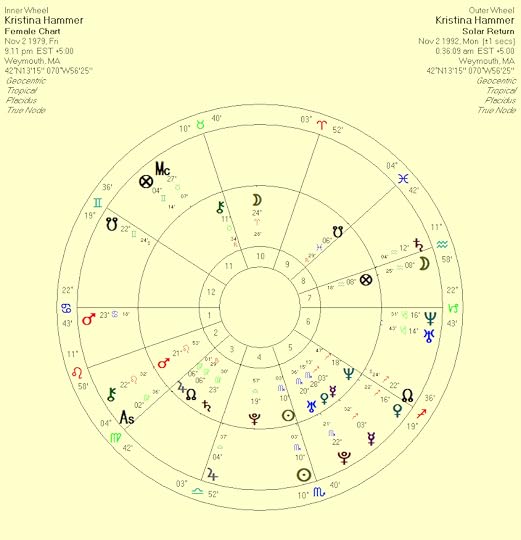 Natal chart with 1992 Solar Return superimposed.
Natal chart with 1992 Solar Return superimposed.This is a problematic return (SR).
The SR Moon, ruler of the natal Ascendant, in now in Aquarius where it conjoins the natal 8th house cusp (death) and SR Saturn, ruler of the natal 8th house cusp. SR Moon and SR Saturn are both square to the natal and SR Sun, which is Lord of the Year by annual profection.
SR Mars conjoins the natal Ascenant. SR chiron conjoins natal Mars and squares natal Uranus.
The SR Lunar Nodes are stationary, with the South Node (Ketu) just inside the 12th house of undoing. When the true lunar nodes are stationary in a solar retrun, the year is marked by significant stressful events that are not easily forgotten. In the myth of Rahu and Ketu, as the dragon was swallowing the elixer of life, Vishnu hurled his discus, severing the dragon’s head from its body — a memorable event in the life of the dragon.
As a final step, let’s consider the lunar return for the month of the accident superimposed on the natal chart.
 Natal chart with Lunar Return of 29 October 1993 (two days before the accident) superimposed.
Natal chart with Lunar Return of 29 October 1993 (two days before the accident) superimposed.The Lunar Return has Scorpio rising with the LR Sun in the first house of the return, which is the 4th of endings of the natal chart.
Lunar return planets Mercury, Mars and Pluto are conjunct natal Uranus and square natal Mars. LR Saturn occupies the natal 8th house (mortal danger) from which LR Saturn opposes natal Mars and squares natal Uranus which is conjunct LR Mercury, Mars and Pluto. LR Uranus and Neptune are conjunct and oppose the natal Ascendant.
The LR MC is very closely opposed to the natal 8th house cusp.
This is clearly a very stressful lunar return and is consistent with a serious accident.
Anthony Louis's Blog
- Anthony Louis's profile
- 29 followers



